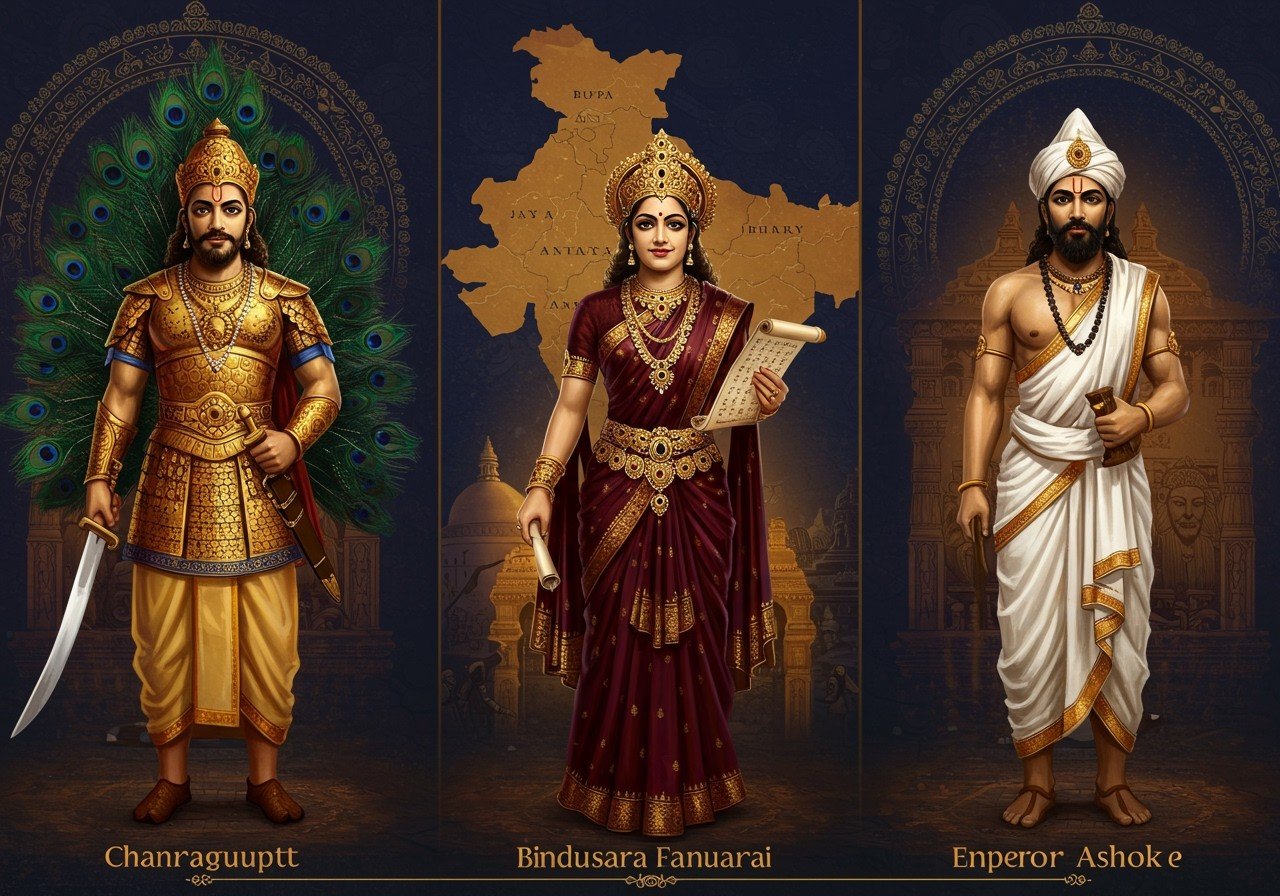
The Mauryan Empire, one of ancient India’s largest and most influential powers, was established by Chandragupta Maurya around 320 BCE. This article delves into the lives and contributions of three pivotal figures: Chandragupta, Bindusara, and Ashoka. Their leadership and strategies significantly expanded the empire’s reach, leaving an enduring legacy on India’s history and cultural landscape.
Chandragupta Maurya: Founding a Dynasty
Chandragupta Maurya is renowned for establishing the Mauryan Empire around 320 BCE, succeeding the Nanda Empire. With the guidance of his mentor, Chanakya, he overthrew the Nanda Dynasty. While Chandragupta’s early life remains shrouded in mystery, his ascent to power is a captivating tale. His military triumphs included significant victories over the Macedonian satrapies left behind by Alexander the Great. Chandragupta’s administrative acumen led to the formation of a centralized government characterized by a sophisticated bureaucracy, fostering economic progress and flourishing trade. Under Chandragupta’s reign, the Mauryan Empire encompassed a vast territory across northern and central India.
Bindusara: Consolidating Power and Expanding the Realm
Bindusara, Chandragupta’s son, inherited the throne around 297 BCE. Known as “Amitraghata” (Slayer of Enemies), Bindusara continued his father’s expansionist policies, conquering the Deccan Plateau and extending the empire’s southern boundaries. He maintained robust diplomatic relations with Hellenistic kingdoms, including the Seleucid Empire. Bindusara’s reign was characterized by internal stability and economic prosperity. He upheld the administrative and military structures established by his father. Though details about his personal life are scarce, Bindusara’s rule set the stage for the golden age under his son, Ashoka.
Ashoka: The Emperor’s Transformative Journey
Ashoka, one of the most celebrated Mauryan emperors, ascended to power around 268 BCE. His early reign involved military campaigns, notably the brutal Kalinga War. The devastation witnessed during the Kalinga War profoundly impacted Ashoka, leading him to embrace Buddhism and champion non-violence (Ahimsa). Ashoka’s edicts, inscribed on pillars and rocks throughout the empire, advocated moral and ethical conduct, religious tolerance, and social welfare. He commissioned missionaries to disseminate Buddhist teachings across Asia, contributing significantly to its global spread. Ashoka’s policies transformed the Mauryan Empire into a benevolent and just state, with his reign often regarded as a pinnacle of Indian history.
The Mauryan Empire: A Legacy of Governance, Culture, and Spirituality
The Mauryan Empire is distinguished by its sophisticated administration and governance. The Arthashastra, attributed to Chanakya, provides valuable insights into the empire’s political and economic strategies. The centralized bureaucracy encompassed a network of spies and a well-organized military. The Mauryan period witnessed advancements in art, architecture, and urban planning, exemplified by the magnificent city of Pataliputra, the empire’s capital. Ashoka’s Rock and Pillar Edicts remain significant archaeological and historical artifacts. The flourishing of Buddhism under Ashoka had a profound and lasting impact on Indian culture and beyond. Following Ashoka’s death, the Mauryan Empire began to decline, eventually disintegrating around 185 BCE, giving rise to the Shunga dynasty. Despite its eventual fall, the legacy of Chandragupta, Bindusara, and Ashoka continues to shape Indian history and culture to this day.
Connecting with Mauryan Heritage Through Traditional Attire with Poojn.in
Interested in experiencing the rich cultural heritage of the Mauryan era? Poojn.in offers a unique opportunity to connect with this historical period through traditional attire. Just as emperors like Ashoka favored silver-bordered dhotis, you too can embrace this ancient tradition.
-
Pure Cotton Dhotis: Crafted from 100% pure cotton, these dhotis are reminiscent of the garments worn during the Mauryan period, offering comfort and authenticity. Experience the feel of history with these meticulously crafted dhotis.
-
Silver Border Dhotis: Elevate your connection to the Mauryan emperors with these special dhotis adorned with silver borders. Representing royal heritage, these dhotis are perfect for special occasions and cultural celebrations.
These dhotis are ideal for various purposes:
- Historical reenactments, bringing the Mauryan era to life.
- Cultural performances showcasing Mauryan history and traditions.
- Traditional ceremonies honoring India’s ancient heritage.
- Educational demonstrations about Mauryan culture and clothing.
Every dhoti from Poojn.in is quality assured and comes with an authenticity certification. This guarantees that you receive genuine traditional garments, allowing you to connect with India’s rich Mauryan heritage. Explore our diverse collection of traditional dhotis and other ritual items that help preserve and celebrate our ancient cultural legacy.
You can learn more about the Mauryan Empire and related topics on our blog:
- Chamundeshwari Temple, Mysore: Your Complete Visit Guide
- Chamundeshwari Temple: Cultural Significance and Impact


